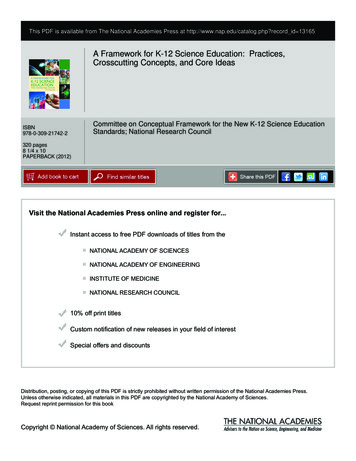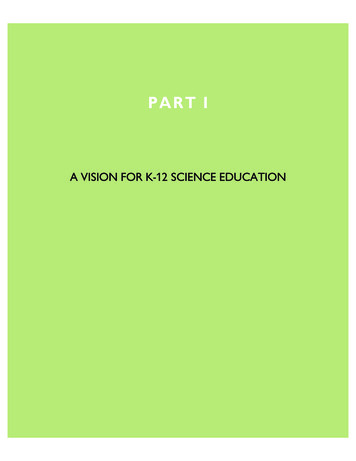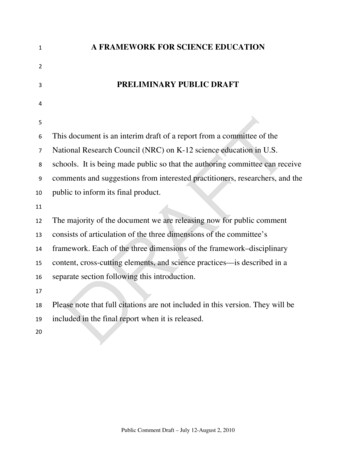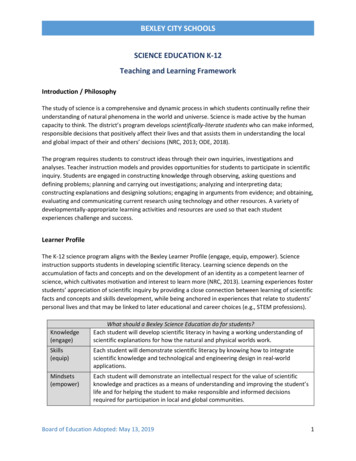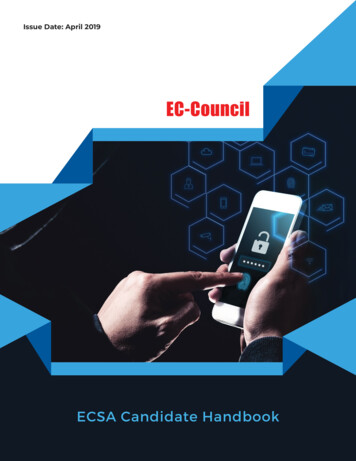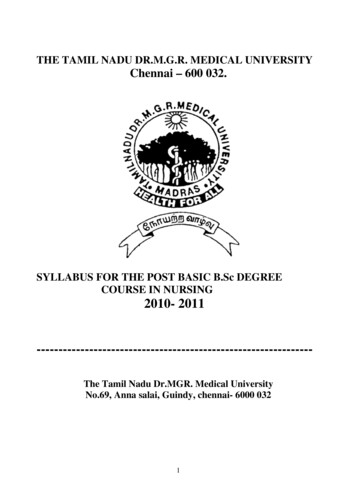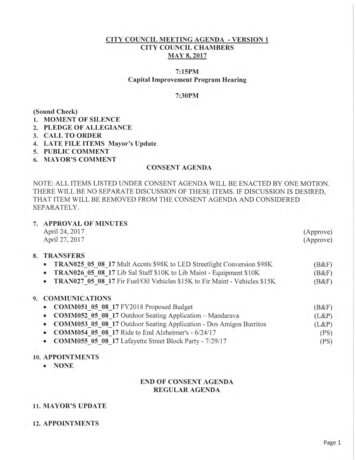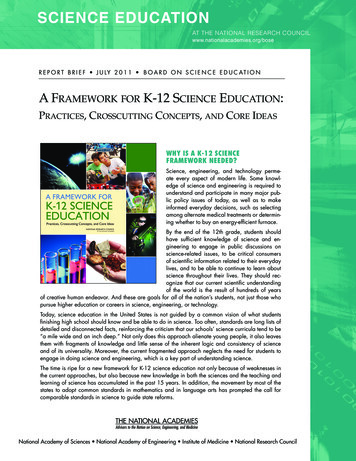
Transcription
SCIENCE EDUCATIONAT THE NATIONAL RESEARCH COUNCILwww.nationalacademies.org/boseR E P O R T B R I E F J U LY 2 0 1 1 B O A R D O N S C I E N C E E D U C AT I O NA Framework for K-12 Science Education:Practices, Crosscutting Concepts, and Core IdeasWHY IS A K-12 SCIENCEFRAMEWORK NEEDED?Science, engineering, and technology permeate every aspect of modern life. Some knowledge of science and engineering is required tounderstand and participate in many major public policy issues of today, as well as to makeinformed everyday decisions, such as selectingamong alternate medical treatments or determining whether to buy an energy-efficient furnace.By the end of the 12th grade, students shouldhave sufficient knowledge of science and engineering to engage in public discussions onscience-related issues, to be critical consumersof scientific information related to their everydaylives, and to be able to continue to learn aboutscience throughout their lives. They should recognize that our current scientific understandingof the world is the result of hundreds of yearsof creative human endeavor. And these are goals for all of the nation’s students, not just those whopursue higher education or careers in science, engineering, or technology.Today, science education in the United States is not guided by a common vision of what studentsfinishing high school should know and be able to do in science. Too often, standards are long lists ofdetailed and disconnected facts, reinforcing the criticism that our schools’ science curricula tend to be“a mile wide and an inch deep.” Not only does this approach alienate young people, it also leavesthem with fragments of knowledge and little sense of the inherent logic and consistency of scienceand of its universality. Moreover, the current fragmented approach neglects the need for students toengage in doing science and engineering, which is a key part of understanding science.The time is ripe for a new framework for K-12 science education not only because of weaknesses inthe current approaches, but also because new knowledge in both the sciences and the teaching andlearning of science has accumulated in the past 15 years. In addition, the movement by most of thestates to adopt common standards in mathematics and in language arts has prompted the call forcomparable standards in science to guide state reforms.National Academy of Sciences National Academy of Engineering Institute of Medicine National Research Council
The National Research Council (NRC)of the National Academy of Scienceswas asked to develop a framework thatwould provide unifying guidance for thenation’s schools to improve all students’understanding of science. The expertcommittee that developed the frameworkused research-based evidence on howstudents learn, input from a wide arrayof scientific experts and educators, andpast national reform efforts, as well as itsmembers’ individual expertise and collective judgment.HOW WILL THE FRAMEWORKBE USED?The framework is designed to be thebasis for the next generation of sciencestandards. Using the practices, crosscutting concepts, and core ideas that theframework lays out, a group of states,coordinated by Achieve, Inc. (a nonprofit education organization), will developstandards for what students should learnat different grade levels.The framework is also designed to beuseful to others who work in science education, including: curriculum developers and assessment designers;HOW THE FRAMEWORK WAS DEVELOPEDNRC convened a committee of 18 experts in educationand scientists from many disciplines to develop theframework drawing on their own expertise, currentresearch , and guidance from small teams of specialists.A draft of the framework was released in the summer of 2010to gather comments from scientists, teachers, and the public.The National Science Teachers Association, the AmericanAssociation for the Advancement of Science, and other groupsaided this effort by collecting feedback from their members.The committee revised the draft in response to all thecomments received.As a final step to ensure high quality, the framework wentthrough the NRC's intensive peer-review process. More than20 experts in the sciences, engineering, and teaching andlearning provided detailed comments. educators who train teachers and create professional development materials for them; state and district science supervisors,who make key decisions about curriculum, instruction, and professionaldevelopment; andThe committee revised the framework again in responseto the experts' comments. science educators who work in informal settings, such as museum exhibitdesigners or writers and producers ofdocumentary films.WHAT IS IN THE FRAMEWORK?The framework consists of a limited number of elements in three dimensions: (1) scientific and engineeringpractices, (2) crosscutting concepts, and (3) disciplinary core ideas in science. It describes how they shouldbe developed across grades K-12, and it is designed so that students continually build on and revise theirknowledge and abilities throughout their school years. To support learning, all three dimensions need to beintegrated into standards, curricula, instruction, and assessment.2A Framework for K-12 Science EducationJuly 2011
DIMENSION 1:SCIENTIFIC AND ENGINEERING PRACTICES1. Asking questions (for science) and defining problems (for engineering)2. Developing and using models3. Planning and carrying out investigations4. Analyzing and interpreting data5. Using mathematics and computational thinking6. Constructing explanations (for science) and designing solutions (for engineering)7. Engaging in argument from evidence8. Obtaining, evaluating, and communicating informationThis dimension focuses on important practices used by scientists and engineers, such as modeling, deve loping explanations or solutions, and engaging in argumentation. For example, all of the disciplines ofscience share a commitment to data and evidence as the foundation for developing claims about the world.As they carry out investigations and revise or extend their explanations, scientists examine, review, andevaluate their own knowledge and ideas and critique those of others through a process of argumentation.These practices have too often been underemphasized in K-12 science education.Engaging in the full range of scientific practices helps students understand how scientific knowledge develops and gives them an appreciation of the wide range of approaches that are used to investigate, model,and explain the world. Similarly, engaging in the practices of engineering helps students understand thework of engineers and the links between engineering and science.The full report describes these eight practices, articulating the major competencies that students should haveby the end of 12th grade and outlining how student competence might progress across the grades.DIMENSION 2:CROSSCUTTING CONCEPTS THAT HAVE COMMON APPLICATION ACROSS FIELDS1. Patterns2. Cause and effect: Mechanism and explanation3. Scale, proportion, and quantity4. Systems and system models5. Energy and matter: Flows, cycles, and conservation6. Structure and function7. Stability and changeJuly 2011A Framework for K-12 Science Education3
The seven crosscutting concepts are key across science and engineering. They provide students with waysto connect knowledge from the various disciplines into a coherent and scientific view of the world. Forexample, the concept of “cause and effect: mechanism and explanation” includes the key understandingsthat events have causes, sometimes simple, sometimes multifaceted; that a major activity of science is investigating and explaining causal relationships and the mechanisms by which they are mediated; and thatsuch mechanisms can then be tested across given contexts and used to predict and explain events in newcontexts.Students’ understanding of these crosscutting concepts should be reinforced by their repeated use in instruction across the disciplinary core ideas (see Dimension 3). For example, the concept of “cause and effect”could be discussed in the context of plant growth in a biology class and in the context of investigating themotion of objects in a physics class. Throughout their science and engineering education, students should betaught the crosscutting concepts in ways that illustrate their applicability across all the core ideas.DIMENSION 3:CORE IDEAS IN FOUR DISCIPLINARY AREASPhysical SciencesPS 1: Matter and its interactionsPS 2: Motion and stability: Forces and interactionsPS 3: EnergyPS 4: Waves and their applications in technologies for information transferLife SciencesLS 1: From molecules to organisms: Structures and processesLS 2: Ecosystems: Interactions, energy, and dynamicsLS 3: Heredity: Inheritance and variation of traitsLS 4: Biological Evolution: Unity and diversityEarth and Space SciencesESS 1: Earth’s place in the universeESS 2: Earth’s systemsESS 3: Earth and human activityEngineering, Technology, and the Applications of ScienceETS 1: Engineering designETS 2: Links among engineering, technology, science, and society4A Framework for K-12 Science EducationJuly 2011
The framework includes core ideas for the physical sciences, life sciences, and earth and space sciencesbecause these are the disciplines typically included in science education in K-12 schools. Engineeringand technology are featured alongside these disciplines for two critical reasons: to reflect the importanceof understanding the human-built world and to recognize the value of better integrating the teaching andlearning of science, engineering, and technology.The focus on a limited number of core ideas in science and engineering is designed to allow sufficient timefor teachers and students to explore each idea in depth and thus with understanding.The full report provides detailed descriptions of each core idea, as well as descriptions of what aspectsof each idea should be learned by the end of grades 2, 5, 8 and 12. Establishing limits for what is to belearned about each core idea for each grade band clarifies the most important ideas that students shouldlearn.HOW CAN THE VISION OF THE FRAMEWORK BE REALIZED?Students will make the greatest strides in learning science and engineering when all components of thesystem—from professional development for teachers to curricula and assessments to time allocated for thesesubjects during the school day—are aligned with the vision of the framework. Aligning the existing K-12system with that vision will involve overcoming many challenges, including teachers’ familiarity with newinstructional practices and the time allocated to science. The full report identifies such challenges to helpeducators and policymakers begin to consider how to meet them. It also offers recommendations to guidestandards developers and lays out a research agenda to inform updates of the framework and standardsin the future.COMMITTEE ON A CONCEPTUAL FRAMEWORK FOR NEW SCIENCE EDUCATIONSTANDARDSHELEN R. QUINN (Chair), Stanford Linear Accelerator Center, Stanford University; WYATT W.ANDERSON, Department of Genetics, University of Georgia, Athens; TANYA ATWATER, Departmentof Earth Science, University of California, Santa Barbara; PHILIP BELL, Learning Sciences, University ofWashington, Seattle; THOMAS B. CORCORAN, Teachers College, Columbia University; RODOLFODIRZO, Department of Biology, Stanford University; PHILLIP A. GRIFFITHS, Institute for Advanced Study,Princeton, New Jersey; DUDLEY R. HERSCHBACH, Department of Chemistry and Chemical Biology,Harvard University; LINDA P.B. KATEHI, Office of the Chancellor, University of California, Davis; JOHNC. MATHER, NASA Goddard Space Flight Center, Greenbelt, Maryland; BRETT D. MOULDING, UtahPartnership for Effective Science Teaching and Learning, Ogden; JONATHAN OSBORNE, School ofEducation, Stanford University; JAMES W. PELLEGRINO, Department of Psychology and Learning Sciences Institute, University of Illinois, Chicago; STEPHEN L. PRUITT, Office of the State Superintendent ofSchools, Georgia Department of Education (until June, 2010); BRIAN REISER, School of Education andSocial Policy, Northwestern University; REBECCA R. RICHARDS-KORTUM, Department of Bioengineering, Rice University; WALTER G. SECADA, School of Education, University of Miami; DEBORAH C.SMITH, Department of Curriculum and Instruction, Pennsylvania State UniversityNational Research Council Staff: HEIDI A. SCHWEINGRUBER, Study Co-Director; THOMASKELLER, Study Co-Director; MICHAEL A. FEDER, Senior Program Officer (until February 2010); MARTINSTORKSDIECK, Board Director; KELLY A. DUNCAN, Senior Program Assistant (until October 2010);REBECCA KRONE, Program Associate; STEVEN MARCUS, Editorial ConsultantJuly 2011A Framework for K-12 Science Education5
For More Information . . .This brief was prepared by the Board on Science Education www.nationalacademies.org/bose. Copies ofthe report, A Framework for K-12 Science Standards: Practices, Crosscutting Concepts, and Core Ideas, areavailable from the National Academies Press at (888) 624-8373 or (202) 334-3313 (in the Washington,DC metropolitan area) or via the National Academies Press webpage at www.nap.edu. The study wasfunded by the Carnegie Corporation. Any opinions, findings, conclusions, or recommendations expressedin the publication are those of the authors and do not necessarily reflect those of the Carnegie Corporation.Related TitlesSuccessful K-12 STEM Education (2011)Surrounded by Science (2010)Engineering in K-12 Education (2009)Learning Science in Informal Environments (2009)Ready, Set, SCIENCE! (2008)Taking Science to School (2007)America’s Lab Report (2006)Systems for State Science Assessment (2006)Copyright 2011 by the National Academy of Sciences. All rights reserved.Permission is granted to reproduce this document in its entirety, with no additions or alterations.6A Framework for K-12 Science EducationJuly 2011
2 A Framework for K-12 Science Education July 2011 The National Research Council (NRC) of the National Academy of Sciences was asked to develop a framework that would provide unifying guidance for the nation’s schools to improve all students’ understanding of science. The expert committee that developed the framework used research-based .




